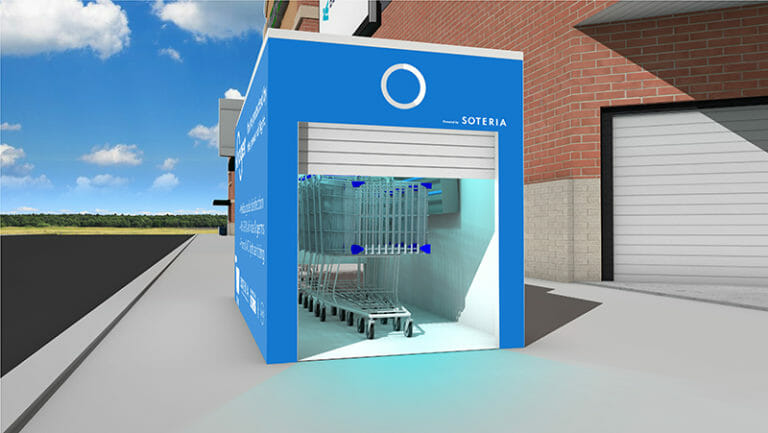Sanitization has been at the forefront of Covid-19 conversations since the very beginning, as soon as it was learned that Covid-19 infections can be caused by coming into contact with a contaminated surface and then touching areas around your mouth and nose. Purchases of hand sanitizer went through the roof, and both individuals and businesses began arming themselves with the tools they needed to keep themselves and those around them safe – sanitizing cloths, wipes, sprays, you name it.
However, now that businesses are starting to re-open their doors and people are heading back out into the world of offices, stores, factories, airports, hospitals, etc., it became evident that there needed to be a faster, more efficient way to help reduce coronavirus transmission in public spaces — especially in a way that couldn’t falter under human error or put individuals in charge at unnecessary risk.
Thankfully, the solution was already out there — UVC light.

What is UVC light?
Ultraviolet (UV) light is an invisible form of light that falls in the electromagnetic spectrum between visible light and X-Rays. While we may not be able to see the light with the human eye, we are exposed to low levels of UV light every day from the sun’s rays. 1
However, not all UV light is the same. There are different regions of wavelength within UV light: ultraviolet A (UVA), ultraviolet B (UVB), and ultraviolet C (UVB), the latter of which falls into the region of 200 nanometers to 280 nanometers, which consists of shorter, more energetic wavelengths of light. Because of this, UVC is particularly useful for disinfection and destroying genetic material in viral particles.2
While UVC light is being talked about a lot right now as a way to protect against viruses like Covid-19, it has actually been used in hospitals for years as a method for cutting down the spread of drug-resistant superbugs and to disinfect surgical suites, in addition to helping to sanitize drinking water.
How does UVC Sterilization work?
The quality of UVC wavelengths themselves is what makes UVC energy such an effective, environmentally friendly, and chemical-free way to sanitize and disinfect surfaces. Because UVC wavelengths are between 200 and 300 nanometers, they are germicidal — meaning they are capable of preventing infection by inactivating the growth or action of microorganisms, such as bacteria or viruses. Basically, when UVC radiation is used against a microorganism, it warps the structure of the genetic material and prevents it from spreading and making more copies of itself. 2
Studies have shown that UVC can be successfully used against other coronaviruses, such as SARS, and prevents the spread of these microorganisms in any environment, like in hospitals where UVC disinfecting has occurred for years.
According to the International Ultraviolet Association, UVC light has been used extensively for more than 40 years in disinfecting drinking water, waste water, air, pharmaceutical products, and surfaces against a whole suite of human pathogens. “ All bacteria and viruses tested to date (many hundreds over the years, including other coronaviruses) respond to UV disinfection,” IUVA states on their UV disinfection fact sheet. “Some organisms are more susceptible to UVC disinfection than others, but all tested so far do respond at the appropriate doses.”3

Can UVC Sterilization Protect Us Against Covid-19?
The National Academies of Sciences, Engineering and Medicine reported that ultraviolet light has been shown to quickly inactivate the novel coronavirus that causes Covid-19.
“In a few laboratory experiments, UVC light has been found to destroy the ability of the SARS-CoV-2 virus to infect a host (for example, a mouse or a person), another indication that it is effective against germs,” their website states. “UVC light has also been shown to inactivate the genetic material in other coronaviruses.” This includes the deadly Middle Eastern respiratory syndrome coronavirus, aka MERS-CoV and severe acute respiratory syndrome-related coronavirus, or SARS.4
While cleaning with non-UVC disinfectants may leave behind some residual contamination, UVC has been shown to achieve a high level of inactivation of the virus related to Covid-19, especially by being able to reach all remaining viruses that may be on the surface, that wipes or other disinfectants may not have been able to reach. 3
“COVID-19 infections can be caused by contact with contaminated surfaces and then touching facial areas ([which is] less common than person-to-person, but still an issue).,” the International Ultraviolet Association states. “Minimizing this risk is key because COVID-19 virus can live on plastic and steel surfaces for up to 3 days … UVC has been shown to achieve a high level of inactivation of a near-relative of COVID-19’s virus (i.e., SARS-CoV-1, tested with adequate dose of 254nm UV while suspended in liquid). IUVA believes similar results can be expected when treating COVID-19’s virus, SARS-CoV-2.” 3
However, it’s important to note that in all these cases, it’s vital to use UVC light correctly in order to avoid harmful exposure to the skin and eyes, which could happen if you come into direct contact with the light.
So, now that you have learned how UVC light works to help sanitize your space and protect both employees and customers from the spread of dangerous viruses, how exactly do you incorporate it into your facility? We’re glad you asked.
Bluewater has created a medical-grade cart cleaning system that uses UVC light to safely, quickly, and completely sterilize carts. Learn more on our website or schedule a discussion with an expert today to find out how you can transport your carts into safe and spotless tools that shoppers trust.
1: https://www.klaran.com/klaran-university/about-uvc 2: https://www.bbc.com/future/article/20200327-can-you-kill-coronavirus-with-uv-light 3: https://iuva.org/IUVA-Fact-Sheet-on-UV-Disinfection-for-COVID-19/ 4: https://sites.nationalacademies.org/BasedOnScience/covid-19-does-ultraviolet-light-kill-the-coronavirus/index.htm











